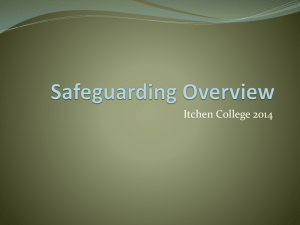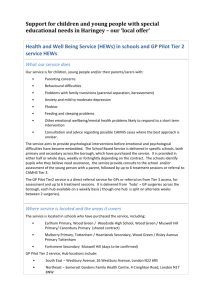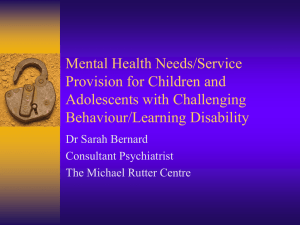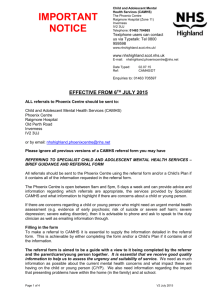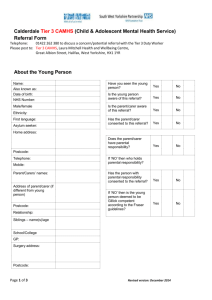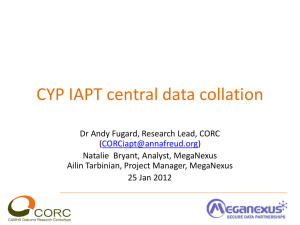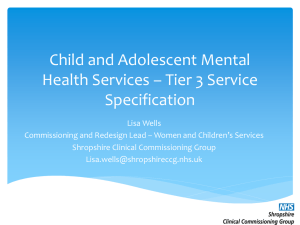(CAMHS) Standard Operating Procedure
advertisement
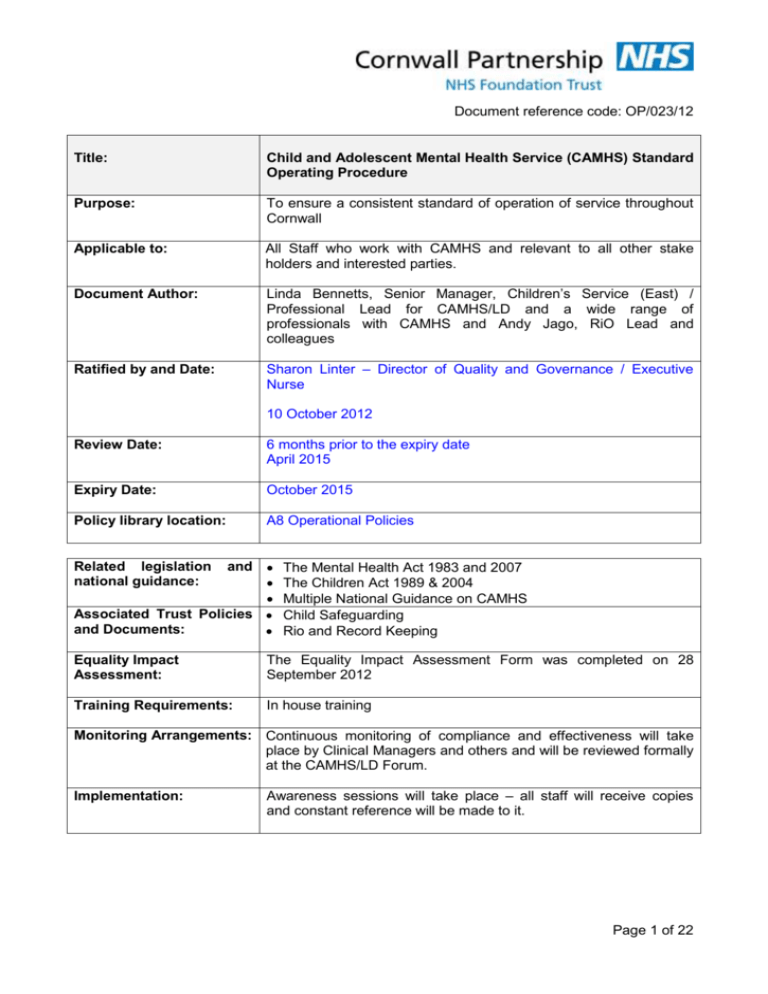
Document reference code: OP/023/12 Title: Child and Adolescent Mental Health Service (CAMHS) Standard Operating Procedure Purpose: To ensure a consistent standard of operation of service throughout Cornwall Applicable to: All Staff who work with CAMHS and relevant to all other stake holders and interested parties. Document Author: Linda Bennetts, Senior Manager, Children’s Service (East) / Professional Lead for CAMHS/LD and a wide range of professionals with CAMHS and Andy Jago, RiO Lead and colleagues Ratified by and Date: Sharon Linter – Director of Quality and Governance / Executive Nurse 10 October 2012 Review Date: 6 months prior to the expiry date April 2015 Expiry Date: October 2015 Policy library location: A8 Operational Policies and Associated Trust Policies and Documents: Related legislation national guidance: The Mental Health Act 1983 and 2007 The Children Act 1989 & 2004 Multiple National Guidance on CAMHS Child Safeguarding Rio and Record Keeping Equality Impact Assessment: The Equality Impact Assessment Form was completed on 28 September 2012 Training Requirements: In house training Monitoring Arrangements: Continuous monitoring of compliance and effectiveness will take place by Clinical Managers and others and will be reviewed formally at the CAMHS/LD Forum. Implementation: Awareness sessions will take place – all staff will receive copies and constant reference will be made to it. Page 1 of 22 Document reference code: OP/023/12 Version Control Version Version 1 Version 2 Date Reviewed 04-Feb-2010 02-Oct- 2012 Version 3 08-Aug-2013 Changes First version Updated, expanded and re-written Additions include Parent Counselling, SPA, CAMHS/LD and new Eligibility Criteria better setting out tiered model of service delivery. By Whom Linda Bennetts Linda Bennetts and multiple other CAMHS clinicians Joe Suart / Ken Sampson / Carol Green and others. This document can be released under the Freedom of Information Act. This document can be accessed and printed via the Intranet Document Library and the Trust Website Page 2 of 22 Document reference code: OP/023/12 Contents 1 Introduction ......................................................................................................................... 5 1.1 What This Policy Explains ................................................................................................... 5 1.2 The Tiered Model of CAMHS Provision ............................................................................... 5 1.3 This policy applies to: .......................................................................................................... 6 1.4 The Choice and Partnership Model (CAPA) ........................................................................ 6 2 The Service ......................................................................................................................... 6 2.1 Service Aims ....................................................................................................................... 6 2.2 Referral Criteria................................................................................................................... 7 2.3 Referral Process and Case Allocation ................................................................................. 7 2.4 Screening of New Referrals ................................................................................................ 8 2.5 How We Measure What We Do......................................................................................... 10 2.6 Clinical Information............................................................................................................ 10 2.7 Assessment ...................................................................................................................... 10 2.8 Risk Assessment .............................................................................................................. 11 2.9 Care Planning ................................................................................................................... 11 2.10 Formal Care Review ......................................................................................................... 11 2.11 Paper Light Files ............................................................................................................... 12 2.12 Diary Management ............................................................................................................ 13 2.13 The Management of Do Not Attend (DNA) Appointments.................................................. 13 2.14 Transition to Adult Services............................................................................................... 13 2.15 Communication with Referrers .......................................................................................... 13 2.16 Service User Involvement ................................................................................................. 13 3 The Workforce .................................................................................................................. 14 3.1 Clinical and Management Supervision .............................................................................. 14 3.2 Staff Appraisals ................................................................................................................. 14 3.3 One Stop Shop / Staff Induction ........................................................................................ 14 3.4 Safeguarding Children – Staff’s Responsibilities ............................................................... 15 4 Clinical Governance .......................................................................................................... 15 4.1 Evidence Based Practice .................................................................................................. 15 4.2 Research .......................................................................................................................... 15 4.3 Audit ................................................................................................................................. 15 4.4 Confidentiality ................................................................................................................... 16 4.5 Complaints ........................................................................................................................ 16 5 Equality, Diversity and Inclusion ........................................................................................ 16 Page 3 of 22 6 Document reference code: OP/023/12 References ....................................................................................................................... 16 Appendix 1 – The Tiered Model of CAMH Service Provision ........................................................ 17 Appendix 2 – Choice and Partnership Approach (CAPA) .............................................................. 18 Appendix 3 - CAMHS Eligibility Criteria using the tiered model of service delivery……………….. Equality Impact Assessment Screening Form ............................................................................... 20 Page 4 of 22 Document reference code: OP/023/12 1 Introduction 1.1 What This Policy Explains This standard operating procedure is for the Child and Adolescent Mental Health Services (CAMHS) and Child and Adolescent Mental Health Learning Disability Services (CAMHS LD). It provides information for team members and for other services about service provision and the care processes. CAMHS are community-based multi disciplinary teams covering Cornwall and the Isles of Scilly. We work in locality-based teams, which cover all areas of Cornwall. The document is under-pinned by ‘Every Child Matters’ (2003) which recognises that children and young people with or without learning disabilities and mental health problems receive help and support from a range of professionals in partner agencies. The service is being developed in accordance with national guidelines as: ‘there is a need to ensure that children and young people with a learning disability who require psychiatric care have access to appropriate services which meet their needs and that they are not disadvantaged because of their disability’ (NSF Standard 9). 1.2 The Tiered Model of CAMHS Provision CAMHS has developed according to the ‘Tiered Model of CAMHS’ service delivery described in ‘Together We Stand’ (1995). Consequently CAMHS and CAMHS LD are defined as a Tier 2 / 3 specialist multi-disciplinary services. As a Tier 2 / 3 specialist service, the CAMHS and CAMHS LD team focuses its resources in two ways Tier 2 promotes tier-1 community capacity by CAMHS training, consultation and some direct work focused on the early recognition, detection and intervention of children and young people with emerging mental health difficulties, primarily using a Brief Solution Focused model. Tier 3 assesses and treats children and young people with moderate to severe mental health difficulties (including mental illness) using evidenced-based treatments that are consistent with guidance and best practice. Children and young people presenting with mental health difficulties are accessed using the following criteria: Severity Persistence Complexity Risk of secondary disability Risk of impairment for the child’s development Presence/absence of protective factors Presence/absence of risk factors Presence/absence of stressful/social/cultural factors Page 5 of 22 Document reference code: OP/023/12 We aim to provide the appropriate level of support for the child and their family in the right way at the right time. We sometimes try to do this by providing consultation to Tier 1 or ‘universal’ services. We will signpost the child and family to other services when this is more appropriate. We work to ensure that when the young person is approaching their 18th birthday we will support a seamless transition into adult services if that is required. Both service development and delivery will be undertaken in close partnership with children / young people and their families and with colleagues from across children’s services. 1.3 This policy applies to: This Standard Operating Procedure applies to all staff, secondees, students and volunteers engaged in delivering specialist mental health services in or on behalf of the service and in all settings where service delivery takes place. The Standard operating Procedure is available to partner agencies, stakeholders, service users and their families. 1.4 The Choice and Partnership Model (CAPA) The Child and Adolescent Mental Health service use, when appropriate, the model for referral management that is service user focused and assists in maximising the best use of resources within CAMHS and CAMHS LD and enhancing choice for all children, families and carers. The model is called the Choice and Partnership Approach Model (CAPA) (see Appendix 2). The management of referral, assessment, planning, treatment and review will be undertaken solely through RiO – the electronic care record system (See standard operating procedure: GOV/034) More information can be accessed from the website: www.capa.co.uk 2 The Service 2.1 Service Aims To provide specialist services to children and young people presenting with mental health needs which include those with a learning disability. To promote improved mental health of children and young people. To enable families, carers and other professionals to positively support children and young people, by providing them with appropriate strategies and skills to improve mental health. To provide timely assessment and intervention appropriate to the needs of each individual child and their family (within our current capacity). To provide training and consultation for tier 1 professionals to maximise their ability to promote mental health within primary care setting. We aim to do this by: Helping to develop problem-solving skills. Supporting parents’, carers’ and other professionals’ ability to manage existing mental health needs, psychological or neuro-developmental problems more effectively. Page 6 of 22 Document reference code: OP/023/12 Enhancing children, young people and families coping abilities. Having a positive impact on the child or young person’s resilience to assist them to manage negative stressors more effectively. Provide diagnosis, formulation and understanding, and the provision of evidence based interventions. To build on the skills and knowledge base of universal and targeted staff in meeting the mental health and learning disability needs of children, young people and families. Promote health and well-being to those who use our services. Service delivery is also based on this and the child / young person and their family / carers can expect: 2.2 To be treated with dignity, respect and appropriate privacy. To receive treatment and care that is appropriate to their need. To have their privacy and rights to confidentiality respected. To be collaborative partners in their treatment and care, by having the information they need to help them make appropriate choices in the type and method of their interventions. The service to consider the context and the influences that affects their whole environment including their family friends, schools and local communities. To respect and respond to the child and young persons development. To promote the ethos of Every Child Matters. Services to be accessible and appropriate to their mental health and learning disability needs using the full range of media that is person friendly to encourage them to engage in their treatment. Referral Criteria Partnership Services for Children, Young People and Families accepts mental health referrals up to the age of 18 years for children and young people. This includes those with a learning disability and / or neuro–developmental disability who are registered with a GP working in Cornwall and the Isles of Scilly. We provide urgent mental health response to children & young people visiting Cornwall. For a definitive list of service provision, please see the Cornwall Partnership NHS Foundation trust’s website. The service applies the following response times to the referral; Within 24 hours for those that require an urgent response (urgent). Within one week (5 working days) where there is an assessed risk (high priority). Within 28 days (routine). Priority is based on clinical need. However, high priority is given to all Children in Care or those managed by the Youth Offending Service. 2.3 Referral Process and Case Allocation All referrals are to the team and not to named clinicians. Page 7 of 22 Document reference code: OP/023/12 Self-referrals are accepted and the service user / family can ring the Children’s Care Management Centre and be provided with a ‘Referral form’. A copy of the Referral Form can be found here; CAMHS Referral Form.doc In addition, referrals can be made by any agency such as; Health providers Social Care Education (via Head Teachers, Deputy Head Teachers, Assistant Head Teachers and Special Education Needs Co-ordinators (SENCos)), Educational Psychologists, Education Welfare and Behaviour Support Service Youth Services. Youth Offending Service. Voluntary Organisations. Referrals are accepted by letter or by phone call if urgent. Any professional seeking to make a referral must endeavour to see the child or young person together with their families/carers and obtain their willingness for a referral to take place. In cases where capacity is a concern, an assessment of need can be undertaken to decide if safety must come first and the service user will be seen by the service as a matter of urgency. Until the assessment has been undertaken by the team, the referrer continues to hold responsibility for the situation. The service does not accept referrals for the sole purpose of compiling legal reports. Referrals are accepted at The Children’s Care Management Centre, Truro Health Park,Truro. TR1 2JA Tel: 01872 221400 or by emailing: Childrens.services@cornwall.nhs.uk 2.4 Screening of New Referrals RiO is our method of recording clinical care, contact and outcome information. This is how we demonstrate the quality of the intervention we deliver. All referrals, without exception, are screened on the first working day of receipt by a clinician. A rota is in place in each office Monday to Friday to receive all new referrals. The team places the need of the child first within the referral process. The duty clinician will assess the level of urgency; this will be recorded with RiO. Additional information that may be required by the referrer may be added at this time. Urgent Response Referrals received by 3pm will be responded to by no later than the next day (including Bank holidays and weekends). For the duration of the urgent assessment, the daytime on-call clinician will assume the role of case manager (within RiO this may be termed Care coordinator) until such time as this role is assigned to another clinician. The admin staff will complete the entry/exit information, including the referral source. They will include the referrer’s name and the client type. Select either mental health or LD; this is Page 8 of 22 Document reference code: OP/023/12 determined by the team to which the referral is made. The reason for referral should then be completed. Admin will then add to CORC/CIC/WAIT spreadsheet. In addition, Admin will check routinely whether every client has been previously known to us prior to RiO ‘go live’ (January - 2010) through ICS and other legacy systems. Admin should check the referred child doesn't have a paper file. Previous files will be accessed. Admin will support clinicians to ensure that all Client Demographics remain up to date and accessible within RiO. Admin staff will scan and upload the letter to the client’s file using the correct naming convention. Once admin have opened a “Presenting Situation & Referral Outcome Decision” within the Core Assessment, the clinician or the admin can update if required after meeting with the service user / family to indicate if the service user has been taken on or referred back. Clinical direction will be provided at the time of referral to admin staff in relation to the action to take after the two week period in which a service user has to book an appointment. In the event the service user does not respond in this two week period, the clinician will direct the admin staff to either routinely close the case, or bring it to the attention of the duty clinician before a decision is made. This process will be recorded in the comments box of the “Presenting Situation & Referral Outcome Decision” within the Core Assessment. Admin will then implement the instructions in the comments box which is situated in “Presenting Situation & Referral Outcome Decision” within the Core Assessment. Admin will send out the first contact letter with an invitation to contact the service. This may result in a telephone consultation. The first invitation to attend for appointment will contain CORC documents for the service user and families to complete. It will also be added to the “CORC/CIC/WAIT” spreadsheet together with the date of the first appointment and the name of the service user’s clinician. Role of Administration staff for the first appointment: Add to the clinician’s RiO diary Transfer from the team referral caseload to the service user’s named Clinician who will be the Case Manager or the Care co-ordinator. Book a room for the appointment Add to the “CORC/CIC/WAIT” spreadsheet Update relevant section of the Core Assessment, Progress notes and upload any relevant documents. An important part of the referral is collecting the family contacts. This information needs to be accessible at all time for the team and will need to be recorded with “Patient Demographics” and “Family History” within Core Assessment section on the RiO system. Areas of importance are as follow; Parent names and contact numbers Who has parental responsibility if different? Who has residence? Contact details and other useful information needed to contact the families who care for children or young people. Page 9 of 22 Document reference code: OP/023/12 2.5 How We Measure What We Do The Trust’s referral response key performance indicator requires all referrals to Partnership Services for Children, Young People and Families receive a clinical contact within 28 days. Additionally, minimum data is required for all children under our care. This is as listed below; Demographics Including: Ethnic Category, GP information, Postcode, The name of the adult with parental responsibility, Phone Contact and name of school. Date of Referral and the Date we received the letter Episode of Care, plus evidence of formal Review during the Episode. Core Assessment Risk Assessment Care Plans Contacts/Use of Diary You must outcome your clinical work using the Diary function in RiO 2.6 Clinical Information Clinical Information that is required within the referral; 2.7 Full description of presenting problem(s) and how they have developed Onset and history of presenting problem(s) including developmental history Child/young person’s development and current functioning Family composition and history Presence of risk and/or resilience factors Other agency information including issues related to safeguarding. History of medical/mental illness in child/young person and his/her family Outline of educational experience History of learning disability and diagnostic information. The team manager’s responsibility is the overall supervision to fulfil the referral process. Assessment The Team will undertake assessment in partnership with other professionals, service users and families. Primarily, this is undertaken at clinics. Home visits are based on clearly recorded clinical needs. RiO is the system on which we record our assessments: The expectation is to record information within key areas to ensure it is accessible 24 / 7 in a format that can be edited and updated as needed. The Core Assessment is where service user information will be collected / the agreed areas of which are outlined in appendix 3. Additional information that is provided by external professionals not using RiO, will be uploaded. Internal referrals (CFT employees) will be required to present their referrals in the appropriate sections of RiO and complete the history of the referral. At this time, the clinician should complete the C-GAS (Children Global Assessment Scale). This should then be sent to the CORC administrator. Page 10 of 22 Document reference code: OP/023/12 2.8 Risk Assessment All patients on RiO must have a risk assessment. The core elements of the risk assessment will help to identify any specialised assessment tools which will supplement this. Risk assessments can be updated and edited as an ongoing assessment. Reviews are to be a maximum of six monthly. All comment sections of the risk assessment require the reviewer to define the status of risk e.g. high, moderate or low followed by a rationale of that decision. The team are not required to undertake HCR20. Use of “Yes / No” buttons – the team are advised that the themes presented are not exclusive, so it is important the clinician considers the wider implication of the topic e.g. “Accidents”. If a “Yes” is selected, then this must be addressed fully in the “Comments” box. If “No” is selected, then the team can record that no issues are identified in the “Comments” box. If there is no relevant themes identified, then do not click the “Yes / No” buttons as this should be non applicable. It is important that all staff remember this assessment is about the impact of mental health in a child’s life, not the inherent risk of being a child. If the child is subject to a safeguarding plan, then complete form three – “Safeguarding Children” on RiO. 2.9 Care Planning All service users within CAMHS will have a Care Plan. The Care Plan will be developed, where possible, with the service user and / or their families. The development takes place during clinical contact and not necessarily with RiO opened or paperwork available at the time of discussion. The team is committed to involving service users and their families and from this developing a Care Plan on RiO that can be shared with them, if they so wish. This plan will be the basis on which all interventions from our services are provided and will require the Key Worker to present this within “Care Planning” in a simple, concise manner that informs services users, families and other staff what we do and when we do it. When clinically indicated for the child’s mental health benefit, arrangements for a parent to receive Specialist Counselling treatment will be included in the child’s care plan. Operational procedures and clinical management structure ensure good clinical governance for this treatment are set out in Operational Procedures for CAMHS Specialist Counselling for Parents. Further information that can support staff using the RiO Care Planning system is provided locally. 2.10 Formal Care Review There are two formal processes for reviewing service users under our care. Process 1; Basic Care Plan Review and Evaluation Service users that meet this requirement are being offered time limited interventions that have low risks identified. At the end of the prescribed intervention, a formal review will take place to allow the service to evidence good practice. When clinically indicated that a parent should be offered Specialist Counselling treatment for the benefit of their child’s mental health, the care plan review will include a review of this treatment. The formal process will be as follows; Page 11 of 22 Document reference code: OP/023/12 At point of discharge, navigate to “Entry / Exit” on RiO and select “Discharge” and record in this form under the “Comments” section “Review” followed by any relevant information. The form is then to be saved. Process 2; CPA Management Service users that meet this requirement that present with complex and challenging needs, their Risk Assessment will reflect high / moderate concerns and Care Planning will be more in-depth and active. Children that have the following indicators are must be managed under CPA; All children and young people who are to be admitted or discharged from an Inpatient Unit. All young people who are transferred to an adult mental health / LD service All those young people where there is a significant risk of death, homicide, major injury, violence or neglect. Where there is an eating disorder with dangerous risk to life and/or health or as advised by the Clinical Psychologist or Clinical Nurse Specialist for Eating Disorders All young people who have extreme challenging behaviour to a point which is likely to require out of hours assistance. Any other child or young person who in the opinion of the clinician or the Clinical Team Manager is likely to benefit from having a CPA care plan. The movement between can be fluid and may change during a service user’s time in the service. 2.11 Paper Light Files Paper Light folders are not to be used as a place to file information of a clinical nature that can be recorded in RiO. It is not an alternative solution. If we seek legal advice about a service user in our care, this is subject to “Legal Privilege” and should not be copied or stored in to RiO, but can be placed in the “Legal” section of the paper light file. Any impact to the care and support of the service user will be recorded in the Care Plan within RiO that is relevant at that time. The following is a list of those items that we have agreed should be placed in a paper light file. Only team admin staff should create a paper light files and state this in the progress notes. Conners Rating Scales (scores and/or analysis to be entered in progress notes by clinician) Methylphenidate, Atomoxetine, Rispiridone or other medication side effect checklists (scanned into record when complete, then destroyed). Child Protection Case Conferences minutes (legal section). Developmental History Form Childhood Asperger Syndrome Test (CAST) Gilliam Autism Rating Scale (GARS) Short Sensory Profile Spence Children’s Anxiety Scale Children In Care Review records Tic Severity Scales Page 12 of 22 2.12 Document reference code: OP/023/12 Moods and Feelings Questionnaire (MFQ) Child and Adolescent Psychiatric Assessment Schedule (CH-A-PAS) Diary Management All contacts must be kept up to date using the RiO “Diary” function. In order to learn more on how to use this function, please see the RiO website; http://intra.cornwall.nhs.uk/Intranet/AZResources/CFT/RiO/RiOANewElectronicPatientRecor d.aspx 2.13 The Management of Do Not Attend (DNA) Appointments The team will meet the standard required for recording and managing DNA appointment. The key requirement is that the initial referrer is communicated to and the safety of the potential service user is assured and recorded clearly in RiO. A risk assessment is undertaken when the decision is made to take no further action in the event of a failure to attend. All closures of children who do not attend can be audited by the Clinical Manager. 2.14 Transition to Adult Services Every client of 17 years and above will require a ‘transition’ plan within their Care Plan on RiO. Not all service users require transition, but it is essential that all service users are assessed for it and the outcome of the assessment of future need is recorded clearly in RiO. Where treatment provided is nearing completion, but might need to continue beyond the 18th birthday, consideration and approval may be given by the clinical team manager to complete the intervention. This authorisation must be recorded in the transition care plan. Transition planning for those experiencing a learning disability often begins from the age of 14 years within education. The specialist team will provide ongoing specialist provision up until 18. Children in Care will also be subject to multi-agency transition planning. 2.15 Communication with Referrers The team will always communicate with the referrer within two weeks of the assessment and at a minimum of six monthly intervals thereafter. At the completion of treatment, referrers and GP’s will receive a written summary outlining the outcomes of intervention. 2.16 Service User Involvement It is the aim of the service to ensure that the child is at the centre of the delivery of the service. There is a need to review the system of communications to ensure that the child/young person is involved in participating in planning their care and also in planning the future delivery of service. Young people are encouraged to let us know their views and there is specific time set aside for each young person within their appointment to be able to do this with the practitioner. Page 13 of 22 Document reference code: OP/023/12 Advocacy is available from Hear our Voice to provide support to the person whilst going through mental health intervention and/or transition to adult services. This can be accessed by contacting: Hear Our Voice 61 Lemon Street Truro Cornwall TR1 2PE Tel: 01872 261989 www.youngpeoplecornwall.org/ 3 The Workforce The workforce comprises of professionals trained in a range of therapeutic interventions. These include creative therapists, nurses, occupational therapists, psychologists, psychiatrist, and social workers. The workforce is committed to developing a client led service and it is the expectation that each of the professionals involved in delivering services will have a core knowledge and competence. 3.1 Clinical and Management Supervision To ensure evidence based practice, each clinician receives clinical and line management supervision regularly. This includes Caseload Management. All members of staff adhere to the Trust’s model of clinical supervision. The allocation of clinical and line management supervision as per the trust supervision policy is to ensure effective caseload supervision and to allow clinical team managers to retain overview. Management supervision will be for 30-60 minutes every six weeks or a minimum of six times a year. 3.2 Staff Performance Reviews All staff will be subject to an annual performance review that includes a Personal Development Plan. 3.3 One Stop Shop / Staff Induction The One Stop Process is designed to streamline the appointment process for new starters and ensure they are provided with everything they require on their first day to allow them to undertake their full duties. All newly appointed staff attend the Trust’s induction programme. All staff employed will have an up to date Disclosure and Barring Service check (DBS) clearance. Newly appointed staff cannot commence work in this service until DBS clearance is verified by the Trust’s Workforce Department. Page 14 of 22 Document reference code: OP/023/12 3.4 Safeguarding Children – Staff’s Responsibilities Partnership Services for Children Young People and Families recognises the importance of commitment to and partnership with local Safeguarding Policies and Procedures. All staff working in the service must attend essential training in Safeguarding Children provided by the Trust. All line management supervision incorporates safeguarding supervision. Children who do not attend and are Children in Care are raised to the attention of the Designated Nurse/ Doctor. The social worker will also be informed. Children who present with high risk and do not attend, the Team Manager is informed, the referrer informed, and a plan identified to engage with the young person and their family. For routine referrals, the practitioner will make contact with the referrer by phone or letter to advice and document on RIO. The Clinical Managers, the Locality Safeguarding Supervisor or the Named Nurse Safeguarding Children can be contacted for advice and consultation. If children in care do not attend new or routine appointments, a risk assessment will be completed and the Named Nurse for Safeguarding Children again can be notified. http://www.safechildren-cios.co.uk/ 4 Clinical Governance 4.1 Evidence Based Practice Partnership Services for Children Young People and Families is committed to providing the highest standards of evidenced based practice and to developing the service. To this end, Clinical Governance is delivered through the CAMHS/LD Clinical Forum, which incorporates representatives from each professional group, a chair from within the group and it offers an open invitation to all staff working in the service including student learners. Partnership Services for Children Young People and Families is committed to achieving quality standards set out by the Quality Network for Community CAMHS (QNCC). 4.2 Research It is the expectation that all staff will, as appropriate, participate and disseminate and publish research in order to develop and improve mental health and learning disability practice and service delivery. All research will be carried out in line with Trust Procedure. 4.3 Audit Partnership Services for Children Young People and Families are members of CAMHS Outcome Research Consortium (CORC) and routinely evaluate service user satisfaction and outcome. Additional audits will be commissioned by the CAMHS Forum. Page 15 of 22 Document reference code: OP/023/12 4.4 Confidentiality The Trust will share information with other agencies on a need to know basis or when required to do so under the law or for the purpose of the protection of the child, vulnerable adult or the public. Information will only be shared when it is in the best interests of the individual. Informed consent to share information will be obtained. If this is not possible and the individual or others are at risk it will be necessary to override this in accordance with the principles of the Data Protection Act 1998. 4.5 Complaints Any complaints regarding Partnership Services for Children Young People and Families will be dealt with in line with the Trust’s Complaints Procedure. 5 Equality, Diversity and Inclusion Cornwall Partnership NHS Foundation Trust’s aim is to provide a service that respects the privacy, dignity, choices and confidentiality of each individual service user, acknowledging their culture, ethnicity, physical ability, gender, sexual orientation, and religious beliefs. Partnership Services for Children, Young People and Families accepts that, to accommodate the needs of the community it serves, it must ensure the highest levels of awareness and understanding of equality and diversity amongst its staff. We aim to promote and deliver healthcare services that are equitable and are appropriate to each service user’s needs regardless of age, disability, race, ethnic or national origin, gender, religion, belief, sexual orientation or domestic circumstances. 6 References Together We Stand, (1995) Department of Health. The Handbook on Child and Adolescent Mental Health, (1995), Department of Health. The National Service Framework for Children, (2004), Department of Health. Every Child Matters, (2003), Parliamentary Green Paper. The Common Assessment Framework, (2004), Department For Education And Skills. Page 16 of 22 Document reference code: OP/023/12 Appendix 1 – The Tiered Model of CAMH Service Provision (Together We Stand, Dept. Of Health, 1995) Tier IV Tier III Tier II Tier I Regional Inpatient Care CAMHS Clinical Staff Primary Mental Health Workers GPs, Health Visitors, Social Workers, Teachers, Youth Offending Service Staff, Sure Start, Children’s Centre Staff, Child Development Centre Staff or PCT Tier l – First point of contact with child or young person where mental health/emotional problems are identified as needing support Tier ll – Child or young person’s mental health and/or emotional problem/difficulty in need of more specialist support and assistance. Tier lll – Child or young persons difficulty determined as mental health disorder requiring the assistance of specialist multi-disciplinary Tier 3 CAMHS. Tier lV – Child or young person requires inpatient care in either a unit for up to 13 yrs or and adolescent unit. Page 17 of 22 Document reference code: OP/023/12 Appendix 2 – Choice and Partnership Approach (CAPA) A Standardised Efficiency Based Programme www.capa.co.uk The Trust has implemented a revised CAPA model to improve team efficiency support patient flows and improved outcome for children and families in Cornwall. This is identified as a key target for the service in order to address access issues and waiting times. Capacity Planning There is one central task to CAPA and that is capacity planning. This enables teams to deal with their current caseload in a much more efficient way. Once capacity is calculated and Choice and Partnership appointments operationalised, the need for waiting lists and allocation meetings ceases. Capacity planning has being progressed through the development of looking at work schedules with each team member identifies time for core and specialist work. What is created is a demand for initial appointments (Choice) calculated based on average accepted referrals per year. Administrative systems are then developed in order that all new accepted referrals can be offered a choice appointment without delay into pre-identified appointment slots. Choice Appointments A Choice Appointment is suitable for all new referrals except emergencies. Staff who undertake these appointments are identified within the capacity planning element of this process. Families are invited to book into a Choice Appointment which they are informed will take up to 60 minutes (to be confirmed). They are offered a choice of day, time, venue and therapist. This process is usually undertaken by phone with the administrative staff enabling both the service and family to agree a mutually convenient time. Choice Appointments negate the need for weekly allocation meetings and waiting lists. Partnership Appointments Families can book into Partnership Appointments following a Choice Appointment. Based on audit results, CAPA predicts that 8% of families go on to work within their own resources to deal with the problem and no further appointments are required. 17% of families agreed that they would seek help from another service outside the Cornwall Partnership NHS Foundation Trust. 64% agreed with the same professional within the service to develop further partnership work. 3% required further partnership work within the service but agreed with a different professional. Psychiatric intervention was only required for 3% of referrals. There was a 3% DNA rate and 3% moved to a different specialist service within Cornwall Partnership NHS Foundation Trust. Page 18 of 22 Document reference code: OP/023/12 Page 19 of 22 Document reference code: OP/023/12 Equality Impact Assessment Screening Form Name of strategy, policy or project area: Cornwall Partnership NHS Foundation Trust – Child & Adolescent Mental Health Service Operational Policy Directorate and service area: Children’s Service Name and contact details of main individual completing assessment: Linda Bennetts, Children’s Service Manager 1 What is the main purpose of the strategy/policy/project (or the main purpose of the changes you want to make)? (for example: a policy may ‘guide staff actions in the event of…’) To give clients/service users, staff and referrers information regarding the standards of care from assessment to discharge for those accessing Children’s Mental Health & Learning Disability Services. 2 What are the main activities of the strategy/policy/project? (for example: a policy might ‘set out core principles, ensure action is legal, give a simple checklist etc’) It provides standards that Service Users can expect and clear operational framework for staff and referrers. 3 Who is intended to benefit from the strategy/policy/project/changes, and how? Patients, Families, Referrers, Partners Agencies, Staff within the service. 4 a) Is the strategy/policy/project/change consistent with the Trust equality policies? (if in doubt- note this and confirm advice has been sought) Yes b) Is the strategy/policy/project/change consistent with human rights legislation? (if in doubt- note this and confirm advice has been sought) Yes 5 Is responsibility for the strategy/policy/project shared with another department, authority or organisation? If so, what responsibility and which bodies? No 6 What impact is the strategy/policy/project/change likely to have on different sections of the community (including staff)? You may wish to use the table below as a prompt. Positive impact (Y or N) Gender • Men • Women Ethnicity Negative Impact (Y or N) Reasoning / evidence Page 20 of 22 Document reference code: OP/023/12 • Asian or Asian British people • Black or Black British people • Chinese people • Gypsy or Roma People • Irish People • People of Mixed Heritage • White People • People of other ethnic backgrounds Asylum Seekers and Refugees Disability People with physical or sensory difficulties Deaf People who use British Sign Language People with mental health issues People with learning disabilities Sexual orientation Lesbians, gay men and bisexual people Trans people Age • Older people(60 +) • Younger people(1725) and children Belief People of different faith groups or beliefs including nonbelievers Travellers Other (please specify) Other specify) 7 17 year olds only The policy enables young people irrespective of IQ the ability to access all forms of mental health services appropriate to their needs. (please If you have indicated there is a possible negative impact, would this difference be: Legal? Yes No (i.e. would it be discriminatory under anti-discriminatory legislation ?) Page 21 of 22 Document reference code: OP/023/12 Level of impact High Medium Low (‘High impact’ may mean: a significant impact on one group/community, of an impact on a broad range of communities or an area where considerable public concern exists) If the difference may be discriminatory in law or of high impact -you will need to complete a full Equality Impact Assessment. This process takes some time and you will need to communicate the risk of delay effectively. If unsure how to answer – or if you have assessed the impact as ‘medium’, you must seek further guidance before proceeding. If any negative impact is judged to be both low and legal, you will still need to complete the rest of the form below and ensure suggested changes are incorporated into policy/function. 8 Could you minimise or remove any negative impact identified (even if this is of low significance)? Explain how: The only area of discrepancy remains the age appropriateness of services where for known clients and those with a learning difficulty the 18th birthday is not a definite cut off for accessing services. The policy has been written to support young people’s services up to the commissioned age of up to 18 years of age. 9 Are there other ways you could adapt the strategy/policy/project/change so that it further promotes equality, equal opportunities or improved relations? Explain how: This is constantly being reviewed and has been in draft operation since 19th March 2009 and has already seen several amendments. On changing legislation and particularly guidance on managing safeguarding for young people the policy will be updated. Signed: Linda Bennetts Date: 28-Sep-2012 Page 22 of 22
